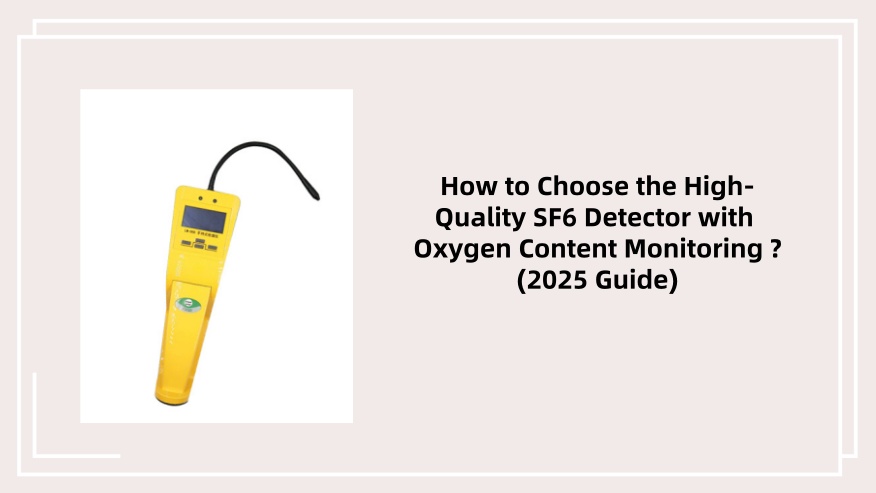
- SF6 Relations
- 2025-09-12
SF6 (sulfur hexafluoride) is a critical gas in high-voltage electrical equipment, valued for its excellent insulation and arc-quenching properties. However, SF6 is a potent greenhouse gas, and its leakage poses dual risks: environmental harm and oxygen depletion in confined spaces (e.g., electrical cabinets, substations). This is where an SF6 detector with oxygen content monitoring becomes indispensable—it safeguards both workers and the environment by tracking two critical parameters in real time.
Why Do You Need an SF6 Detector with Oxygen Content Monitoring?
The dangers of unmonitored SF6 leaks extend beyond environmental impact. In enclosed areas, leaking SF6 displaces air, lowering oxygen levels to life-threatening thresholds (below 19.5% oxygen is considered unsafe for human exposure). Without simultaneous monitoring, workers may not notice oxygen depletion until symptoms like dizziness or suffocation occur—too late to react.
An SF6 detector with oxygen content monitoring addresses this gap by:
1. Alerting to SF6 concentrations exceeding safety limits (e.g., 1000 ppm, the occupational exposure limit set by OSHA) to prevent toxic inhalation and environmental release.
2. Tracking oxygen levels to ensure they stay within safe ranges, mitigating the risk of asphyxiation in confined spaces.
3. Eliminating the need for separate SF6 and oxygen detectors, reducing equipment costs and simplifying on-site operations.
Core Features of a High-Quality SF6 Detector with Oxygen Content Monitoring
Not all SF6 detectors with oxygen monitoring are created equal. To meet industrial needs, top-tier models include these essential features:
1. Dual-Sensor Accuracy
Reliable detection starts with high-performance sensors:
SF6 Sensor: Infrared (IR) sensors are preferred for SF6, as they offer long lifespans (5–10 years), low drift, and resistance to cross-interference from other gases (e.g., moisture, dust). Avoid electrochemical SF6 sensors, which require frequent calibration and have shorter lifespans.
Oxygen Sensor: Electrochemical sensors excel here, providing fast response times (≤10 seconds) and precise readings (0–25% O₂), ideal for real-time safety alerts.
2. Real-Time Alerts & Visualization
Look for detectors with multi-level alarms (audible, visual, and vibrating) to ensure workers notice risks even in noisy environments (e.g., substations). A backlit LCD screen should display both SF6 concentration and oxygen levels clearly, with color-coded indicators (green = safe, yellow = warning, red = alarm) for quick interpretation.
3. Portability & Durability
Industrial use demands portability for on-site inspections (e.g., GIS equipment maintenance) and durability to withstand harsh conditions. Opt for lightweight models (≤1.5 kg) with IP65 or higher protection ratings—this ensures resistance to dust, water splashes, and extreme temperatures (-20°C to 50°C).
4. Data Logging & Connectivity
For compliance and maintenance, choose detectors with built-in data logging (storing 10,000+ readings) and Bluetooth/Wi-Fi connectivity. This allows users to export data to computers or cloud platforms, simplifying report generation for regulatory bodies (e.g., EPA, IEC).
Key Application Scenarios for SF6 Detectors with Oxygen Content Monitoring
This equipment is critical across industries relying on SF6:
1. Electrical Power Industry
Substations, GIS (Gas-Insulated Switchgear) cabinets, and transformer rooms are primary use cases. Technicians use portable **SF6 detectors with oxygen content monitoring** during routine maintenance to check for leaks before entering confined spaces, ensuring compliance with safety standards like IEEE C37.122.
2. Semiconductor & Manufacturing
SF6 is used in semiconductor etching and metal processing. Factories use fixed detectors in production areas to monitor gas levels continuously, preventing leaks that could harm workers or damage equipment.
3. Environmental Monitoring
Utility companies and environmental agencies use these detectors to measure SF6 emissions, supporting efforts to reduce greenhouse gas footprints and meet global agreements (e.g., the Paris Agreement).
How to Choose the Right SF6 Detector with Oxygen Content Monitoring
To select a detector that fits your needs, consider these factors:
- Accuracy & Calibration: Ensure the device meets international standards (e.g., IEC 61779) and offers easy calibration (preferably with auto-calibration features to reduce downtime).
- Battery Life: For portable models, aim for 8+ hours of continuous use on a single charge—critical for full-day inspections.
- Certifications: Look for certifications like ATEX (for explosive environments) or CSA (for North American compliance) to ensure safety in your specific industry.
- After-Sales Support: Choose brands that offer 24/7 technical support and sensor replacement services, as sensors are the heart of the detector.
An SF6 detector with oxygen content monitoring is more than a tool—it’s a safeguard for workers, equipment, and the environment. By combining SF6 leak detection with oxygen level tracking, it addresses the dual risks of toxic gas exposure and oxygen depletion, ensuring compliance with safety regulations and reducing environmental impact. When selecting a model, prioritize accuracy, durability, and user-friendly features to maximize its value in your operations. For industries relying on SF6, this detector isn’t an option—it’s a necessity.
Leave a Reply